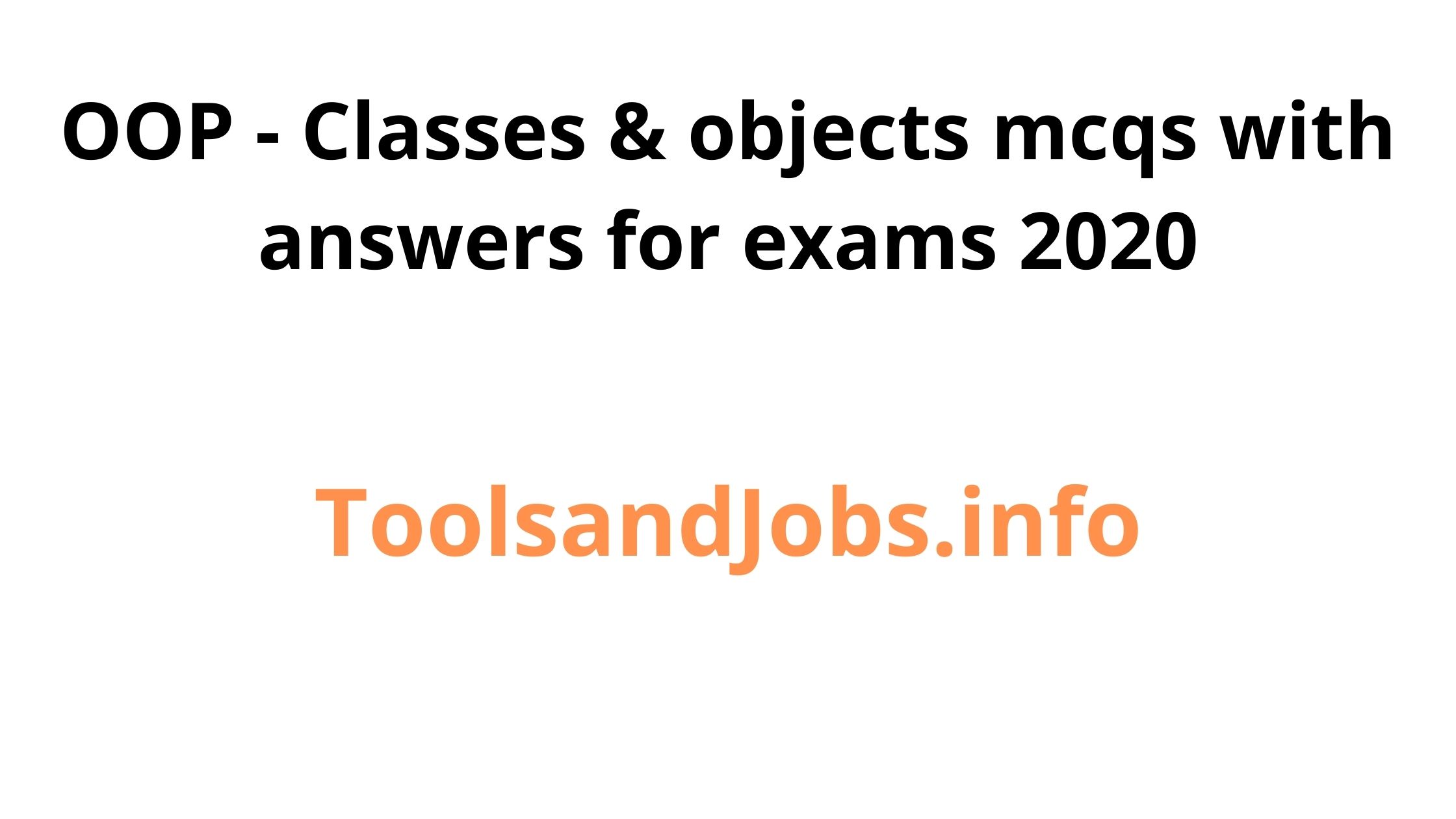OOP - Classes & objects mcqs with answers. This is part 1 of object oriented programming of topic classes & objects mcq's for all competitive exams and SPPU exams 2020.
1 Question Every class has at least one constructor function, even when none is declared.
A TRUE
B FALSE
Answer A
2 Can constructors be overloaded?
A TRUE
B FALSE
Answer A
3 What is the difference between struct and class in terms of Access Modifier?
A By default all the struct members are private while by default class members are public.
B By default all the struct members are protected while by default class members are
private.
C By default all the struct members are public while by default class members are private.
D By default all the struct members are public while by default class members are protected.
Answer C
4 An abstract class can be instantiated.
A TRUE
B FALSE
Answer B
5 The default access level assigned to members of a class is ______
A Private
B Public
C Protected
D Needs to be assigned
Answer A
6 There is nothing like a virtual constructor of a class.
A TRUE
B FALSE
Answer B
7 Which of the following operators allow defining the member functions of a class outside
the class?
A ::
B ?
C :?
D %
Answer A
8 Which type of class has only one unique value for all the objects of that same class?
A This
B Friend
C Static
D Both a and b
Answer C
9 Which one of the following is not a fundamental data type in C++?
A Float
B string
C Int
D Char
Answer B
10 What is a constructor?
A A class automatically called whenever a new object of this class is created.
B A class automatically called whenever a new object of this class is destroyed.
C A function automatically called whenever a new object of this class is created.
D A function automatically called whenever a new object of this class is destroyed.
Answer C
11 Under what conditions a destructor destroys an object?
A Scope of existence has finished
B Object dynamically assigned and it is released using the operator delete.
C Program terminated.
D Both a and b.
Answer D
12 If a member needs to have unique value for all the objects of that same class, declare the
member as
A Global variable outside class
B Local variable inside constructor
C Static variable inside class
D Dynamic variable inside class
Answer B
13 If a member needs to have unique value for all the objects of that same class, declare the
member as
A Global variable outside class
B Local variable inside constructor
C Static variable inside class
D Dynamic variable inside class
Answer B
14 When class B is inherited from class A, what is the order in which the constructers of
those classes are called
A Class A first Class B next
B Class B first Class A next
C Class B's only as it is the child class
D Class A's only as it is the parent class
Answer A
15 Which one of the following is not a valid reserved keyword in C++?
A Explicit
B Public
C Implicit
D Private
Answer C
16 Variables declared in the body of a particular member function are known as data
members and can be used in all member functions of the class.
A TRUE
B FALSE
Answer B
17 In a class definition, data or functions designated private are accessible
A to any function in the program.
B only if you know the password.
C to member functions of that class.
D only to public members of the class.
Answer C
18 A member function can always access the data
A in the object of which it is a member.
B in the class of which it is a member.
C in any object of the class of which it is a member.
D in the public part of its class.
Answer A
19 Classes are useful because they
A can closely model objects in the real world.
B permit data to be hidden from other classes.
C bring together all aspects of an entity in one place.
D Options A, B and C
Answer D
20 For the object for which it was called, a const member function
A can modify both const and non-const member data.
B can modify only const member data.
C can modify only non-const member data.
D can modify neither const nor non-const member data.
Answer D
21 Dividing a program into functions
A is the key to object-oriented programming.
B makes the program easier to conceptualize.
C may reduce the size of the program.
D Option B and C
Answer D
22 An expression
A usually evaluates to a numerical value.
B may be part of a statement.
C always occurs outside a function.
D Option A and B
Answer D
23 A variable of type char can hold the value 301.
A TRUE
B FALSE
Answer B
24 In an assignment statement, the value on the left of the equal sign is always equal to the
value on the right.
A TRUE
B FALSE
Answer B
25 It’s perfectly all right to use variables of different data types in the same arithmetic
expression.
A TRUE
B FALSE
Answer A
26 A function’s single most important role is to
A give a name to a block of code.
B reduce program size.
C accept arguments and provide a return value.
D help organize a program into conceptual units.
Answer D
27 A function argument is
A a variable in the function that receives a value from the calling program.
B a way that functions resist accepting the calling program’s values.
C a value sent to the function by the calling program.
D a value returned by the function to the calling program.
Answer C
28 When arguments are passed by value, the function works with the original arguments in
the calling program.
A TRUE
B FALSE
Answer B
29 Which of the following can legitimately be passed to a function?
A A constant
B A variable
C A structure
D All of the above
Answer D
30 How many values can be returned from a function?
A 0
B 1
C 2
D 3
Answer B
Click to read part 2 of OOP- classes and objects mcqs


